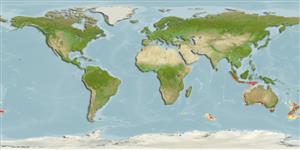Classification / Names
Common names | Synonyms | Catalog of Fishes (gen., sp.) | ITIS | CoL | WoRMS | Cloffa
Elasmobranchii (sharks and rays) >
Squaliformes (Bramble, sleeper and dogfish sharks) >
Centrophoridae (Gulper sharks)
Etymology: Centrophorus: Greek, kentron = sting + Greek, pherein = to carry (Ref. 45335); zeehaani: Named for the commercial vessel, Zeehaan.
Environment / Climate / Range
Ecology
Marine; bathydemersal; depth range 208 - 701 m (Ref. 76933), usually 400 - ? m (Ref. 76933). Subtropical, preferred ?
Indian and Pacific oceans of Australia.
Size / Weight / Age
Maturity: Lm ? range ? - ? cm
Max length : 91.0 cm TL male/unsexed; (Ref. 76933); 102.7 cm TL (female)
Short description
Morphology | Morphometrics
This moderate-sized species has the following set of adult characters: length of pre-second dorsal 62.8-64.8% TL, 8.3-9.8 times dorsal-caudal space; length of pre-first dorsal 28.3-30.7% TL; interdorsal space 20.0-23.7% TL, 3.0-3.5 times the dorsal-caudal space; dorsal-caudal space 6.4-7.9% TL, 4.2-4.7 in pectoral-pelvic space; long and moderately robust head, its length 23.3-24.3% TL, 2.5-2.9 times mouth width and its width 11.8-13.1% TL, 4.9-5.4 in pre-second dorsal length, width at anterior of nostrils 5.5-6.3% TL; moderately long snout, its pre-oral length 9.4-10.1% TL, 1.6-1.9 times head height at anterior of mouth, 1.0-1.2 times mouth width; horizontal preorbital length 5.6-6.3% TL; horizontal prenarial length 3.4-4.2% TL); large mouth, its width 8.3-9.6% TL; moderately sized pectoral fin, its anterior margin 11.4-12.6% TL, 2.3-2.8 times base length; large caudal fin, its dorsal caudal margin 17.9-20.8% TL; 2.6-2.9 times dorsal-caudal space; moderately-sized first dorsal fin, its height 6.0-7.0% TL, with a relatively robust spine, its base width 0.9-1.2% TL; dorsal fins of juveniles have a distinct blackish margin extending from mid-anterior margin to near free rear tip while in adults with a less distinct, but obvious, dark margin; adults of both sexes with upper teeth upright, only slightly oblique laterally, different shape, and much smaller than lower teeth; juveniles with more oblique cusps, but not strongly oblique; 37-45/30-33 tooth row count (based on non-type skeletal specimens, n=8); flank denticles are flat, block-like, not overlapping, scalloped edges; 114-117 (mean 115.4) total vertebral centra, 54-56 (55.2) monospondylous precaudal centra; 28-31 (29.4) diplospondylous precaudal centra; 84-86 (84.7) precaudal centra; 31 (30-32) diplospondylous caudal centra (Ref. 76933).
Life cycle and mating behavior
Maturity | Reproduction | Spawning | Eggs | Fecundity | Larvae
White, W.T., D.A. Ebert and L.J.V. Compagno, 2008. Description of two new species of gulper sharks, genus Centrophorus (Chondrichthyes: Squaliformes: Centrophoridae) from Australia. pp. 1-21. In P.R. Last, W.T. White and J.J. Pogonoski (eds). Descriptions of new Australian chondrichthyans. CSIRO Marine and Atmospheric Research Paper no. 22. 365 p. (Ref. 76933)
IUCN Red List Status (Ref. 115185)
CITES (Ref. 94142)
Not Evaluated
Threat to humans
Harmless
Human uses
More information
Common namesSynonymsMetabolismPredatorsEcotoxicologyReproductionMaturitySpawningFecundityEggsEgg development
Age/SizeGrowthLength-weightLength-lengthLength-frequenciesMorphometricsMorphologyLarvaeLarval dynamicsRecruitmentAbundance
ReferencesAquacultureAquaculture profileStrainsGeneticsAllele frequenciesHeritabilityDiseasesProcessingMass conversion
Tools
Special reports
Download XML
Internet sources
